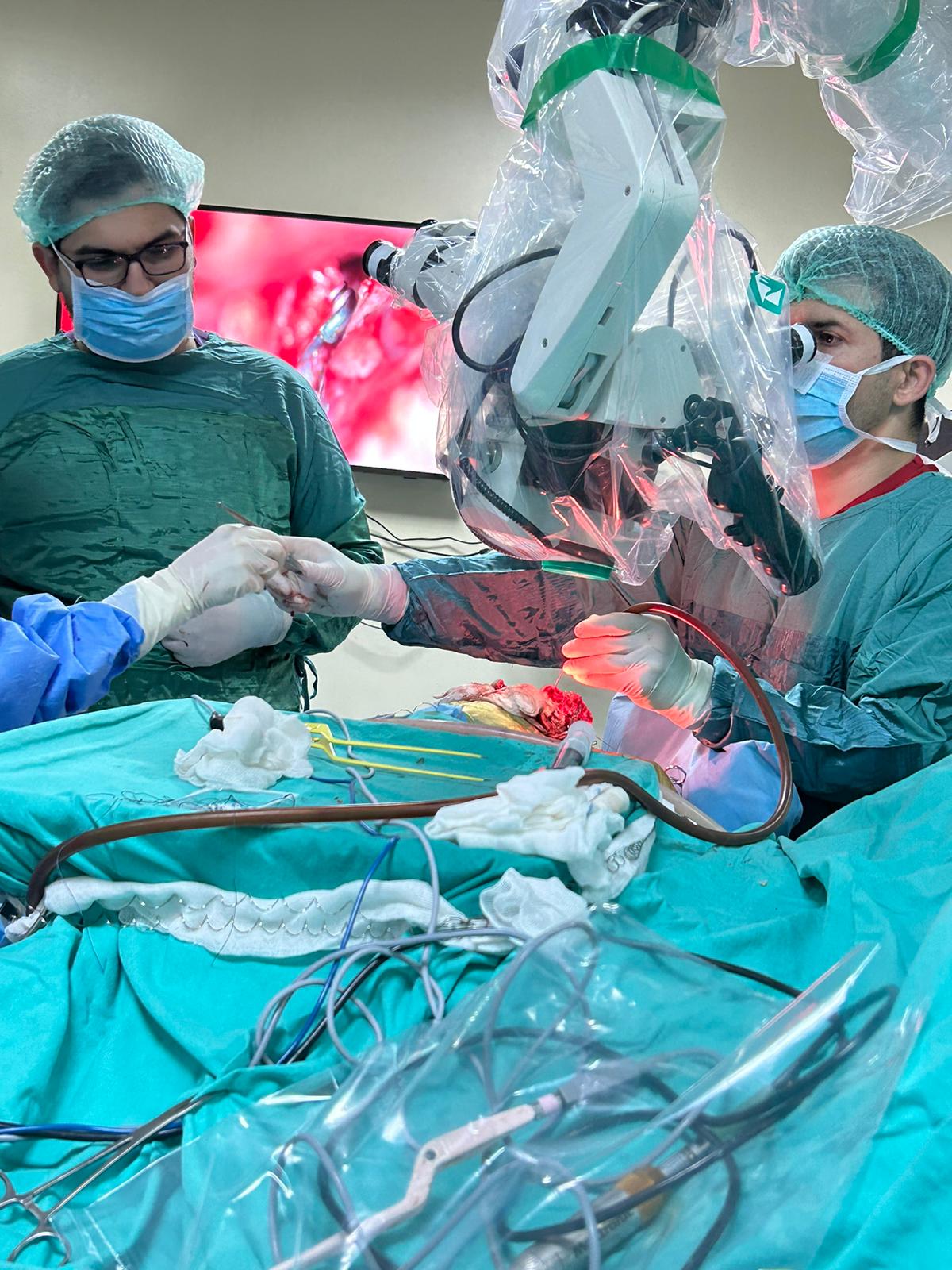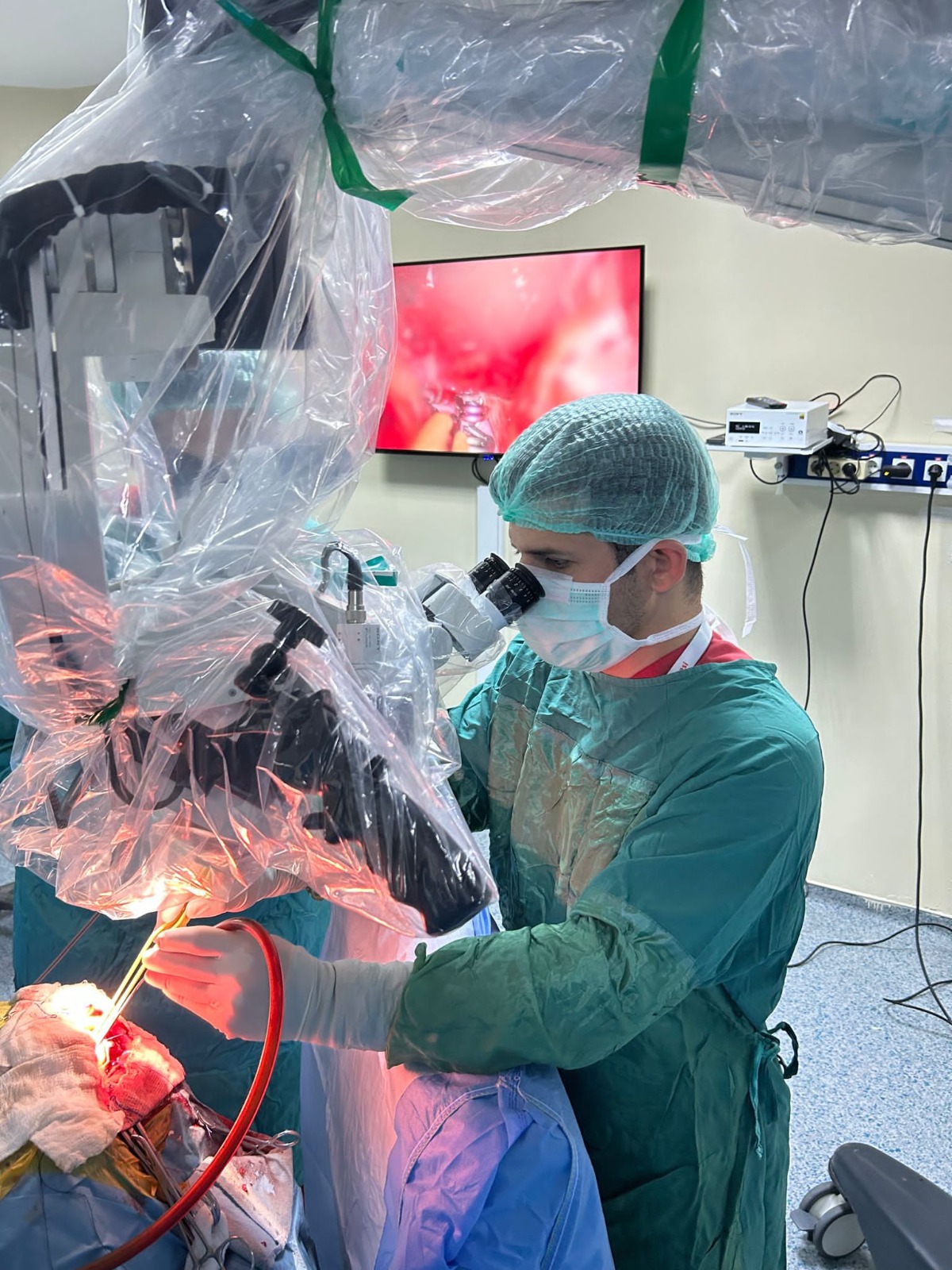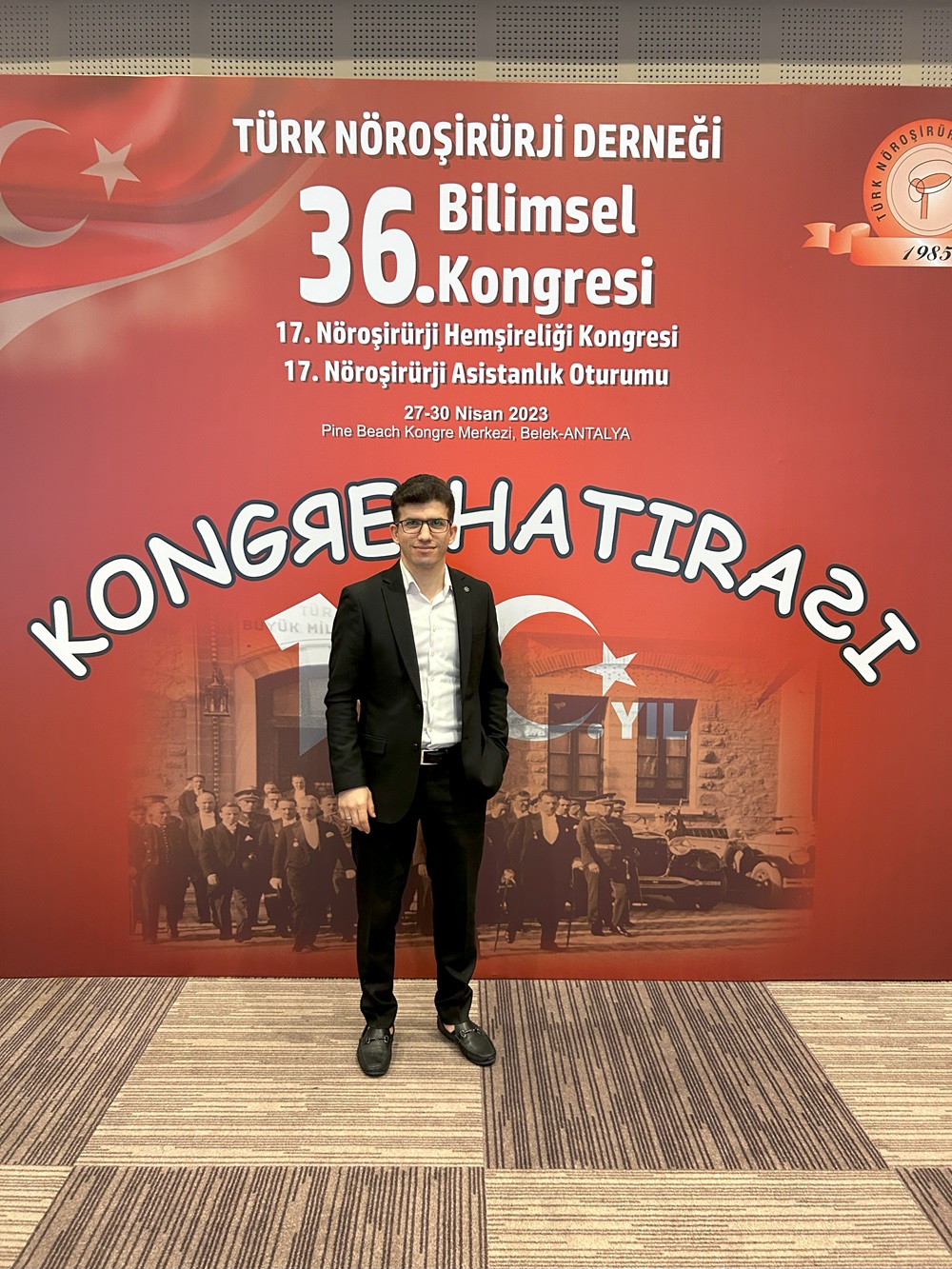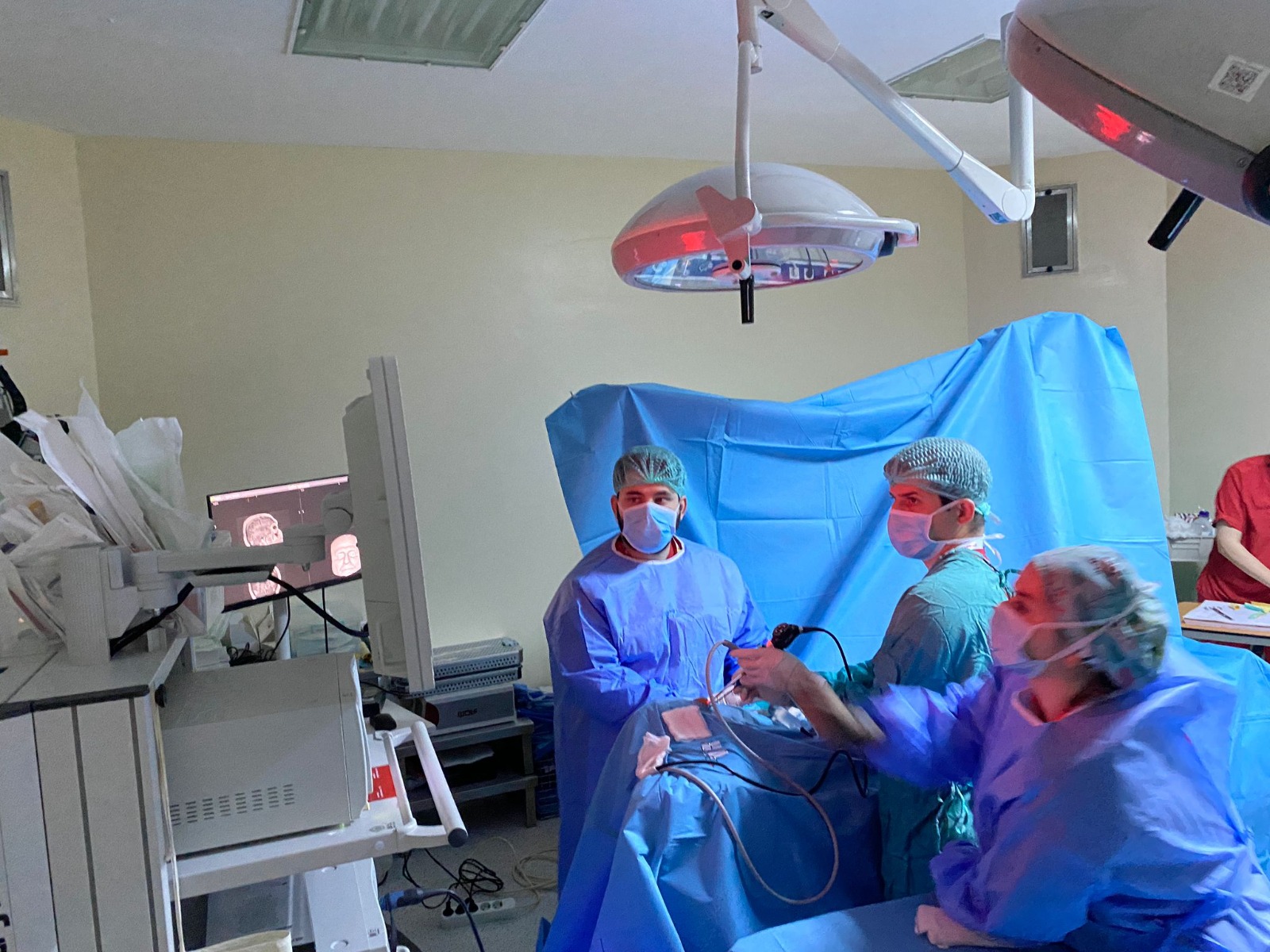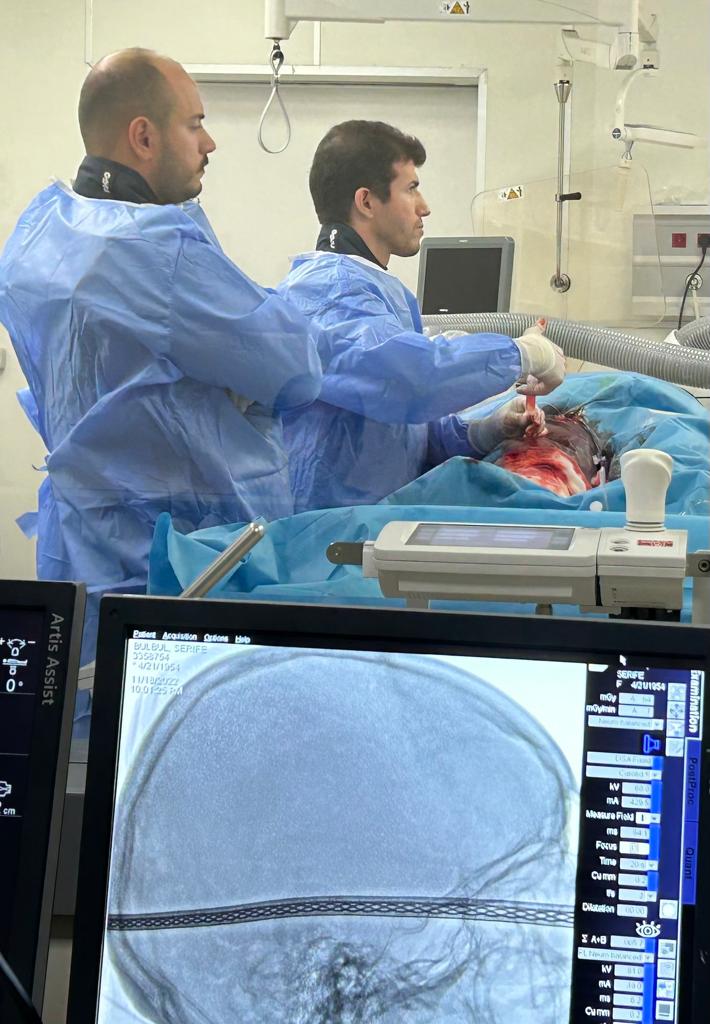ABSTRACT
Objective: To analyse the relationship between peritumoural oedema volume and tumour volume in relation to the impact of
metastatic posterior fossa tumour survival rates.
Study Design: An observational study.
Place and Duration of Study: Umraniye Training and Research Hospital, İstanbul, Turkey, from 2011–2021.
Methodology: Fifty-six cancer patients who had been operated upon for cerebellar metastases were analysed retrospectively. To
investigate the effect of oedema on survival, patients with a single cerebellar metastasis were evaluated retrospectively. Those patients
had a single metastasis located in the cerebellum and did not receive radiotherapy or corticosteroids before surgery. OsiriX MD DICOM
viewer was used to calculate the volumes of the tumour and the oedema using fluid-attenuated inversion recovery (FLAIR) and contrast-
enhanced magnetic resonance imaging (MRI). The patients were separated into two groups, and the cut-off limit for the oedema to-tu-
mour ratio was set to two. Survival analysis was performed on the two groups.
Results: When the primary sites of the tumours were evaluated, 60.7% were located in the lungs (n = 34), 10.7% were located in the
breasts (n = 6), 10.7% were located in the gastrointestinal tract (n = 6), 7.1% were located in the renal region (n = 4), 5.4% were
located in the gynaecologic tract (n = 3), and 5.4% were located in other parts of the body (n = 3). A univariate analysis showed that
overall survival duration was significantly longer in the subgroup with breast cancer (83.3%) and in those patients with a peritumoural
oedema volume to tumour volume ratio of less than two (27.6%, p <0.05). Negative prognostic factors were lung cancer and high peritu-
moural oedema volume.
Conclusion: Significant peritumoural oedema was linked to a poor prognosis for cancer patients with a single cerebellar metastasis,
especially with lung cancer as the primary source.
Key Words: Cerebellar metastases, Cerebellum, OsiriX MD, Tumour volume.
How to cite this article: Ramazanoglu AF, Varol E, Avci F, Etli MU, Aydin S, Yaltirik CK. Peritumoural Oedema as a Predictor of Overall
Survival for Patients with Posterior Fossa Metastases. J Coll Physicians Surg Pak 2023; 33(02):136-140.
INTRODUCTION
Intracranial metastases are the common complication in cancer
patients, and 30–40% of cancer patients develop brain metas-
tases at some point during the course of their disease.1
A total of
20% of brain metastases occur in the posterior fossa.2
If the
metastasis remains untreated, the patient runs the risk of devel-
oping serious conditions such as acute hydrocephalus, brain-
stem compression, cerebellar tonsillar herniation, and falling
into a coma.2
There are various factors that affect the overall
survival rates for intracranial metastases patients,3,4 with func-
tional impairment (measured using the Karnofsky Performance
Scale Index), the occurrence of extracranial metastases, and
adjuvant chemotherapy or radiotherapy being the primary
factors that affect life expectancy.1,5,6
Correspondence to: Dr. Cumhur Kaan Yaltirik, Depart-
ment of Neurosurgery, Umraniye Training and Research
Hospital, Istanbul, Turkey
E-mail: dr_cky@yahoo.com
……………………………………………..
Received: July 30, 2022; Revised: December 11, 2022;
Accepted: January 03, 2023
DOI: https://doi.org/10.29271/jcpsp.2023.02.136
However, there are only a few studies in literature on the radiolog-
ical factors impacting the estimated survival rates of patients
with posterior fossa metastasis.7
In this study, the aim was to find
the correlation between peritumoural oedema volume and
tumour volume in relation to the impact of metastatic posterior
fossa tumours on patient survival rate.
In this study, 172 patients who had been operated on at the
Ümraniye Research and Training Hospital, between 2011 and
2021 were studied retrospectively using their hospital records.
To investigate the effect of oedema on survival, patients with a
single cerebellar metastasis were evaluated retrospectively.
The patients had a single metastasis located in the cerebellum
and did not receive radiotherapy or corticosteroids before
surgery. The pathology report was compatible with metastasis,
and the preoperative magnetic resonance imaging (MRI)
included both contrast-enhanced images and fluid-attenuated
inversion recovery (FLAIR) sequences, which were included in
the study. Patients who did not have a brain MRI prior to surgery,
whose clinical information could not be obtained, who had multi-
focal cerebral or cerebellar metastasis, who did not have a
primary focus of cancer, who were diagnosed with a neurodegen-
erative disease, and who received corticosteroid therapy for any
reason were excluded from the study. Following these criteria,
Ali Fatih Ramazanoglu, Eyup Varol, Furkan Avci, Mustafa Umut Etli, Serdar Aydin and Cumhur Kaan Yaltirik
Journal of the College of Physicians and Surgeons Pakistan 2023, Vol. 33(02): 136-140 137
56 patients were retrospectively analysed. All study participants
had undergone surgical resection and received radiotherapy
during the postoperative period. Thirty-four patients with a score
of less than two and twenty-two patients with a score of more
than two were included in the study. The cut-off limit for the oede-
ma-to-tumour ratio was two. The participants were divided into
two groups, and survival analysis was performed on two groups.
OsiriX MD is cleared by the FDA as a class II medical device for
diagnostic imaging. Hence, OsiriX MD software was used to
calculate tumour volume and peritumoural oedema volume.8
The tumours were viewed on T1 contrast-enhanced MRI
images, and a region of interest9
was marked around the tumour
tissue. Peritumoural oedemas were viewed via MRI, ROIs, and
FLAIR sequences were marked around the peritumoural
oedema tissue. The markings were made on every section of the
MRI images, and the peritumoural oedema volume was calcu-
lated using OsiriX software. To isolate the peritumoural oedema
volume from the tumour volume, the tumour volume was
subtracted from the total volume, and the peritumoural volume
was obtained. The ratio of peritumoural oedema volume to
tumour volume was then calculated (Figures 1a-1c). The
measurements were performed by two different researchers
simultaneously; there were no statistically significant interob-
server differences between the measurements.
Figure 1 (a,b,c): Calculation of tumour volume and peritumoural oedema
volume using OsiriX MD. (d,e): Kaplan–Meier survival analysis of the
study groups.
Statistical Package for the Social Sciences (SPSS) version 25.0
(IBM Corp., Armonk, NY, USA) was used for the statistical anal-
ysis of the results. Descriptive statistics, including numbers,
percentages, and mean and standard deviation (SD) were used
to evaluate the results of the study. The Kaplan–Meier analysis
method was used to calculate survival. The effects of prognostic
factors on survival were evaluated using Cox regression anal-
ysis. The results were evaluated with 95% confidence interval
and p <.05 was considered significant.
RESULTS
The median age of the participants was 62 (30–87), and 50%
were 63 years or older (n = 28). A total of 69.6% (n = 39) of the
patients were male, and 30.4% (n = 17) were female. When the
primary sites of the cancer tumours were evaluated, 60.7%
were located in the lungs (n = 34), 10.7% were located in the
breasts (n = 6), 10.7% were located in the gastrointestinal tract
(n = 6), 7.1% were located in the renal region (n = 4), 5.4% were
located in the gynaecologic tract (n = 3), and 5.4% were located
in other areas (n = 3). The median volume of the tumours
viewed in T1 contrast-enhanced MRI images was 9.54 cm3
(0.28–30.1 cm3), and the median volume of the peritumoural
oedemas, which was calculated using the total peritumoural
oedema volume in FLAIR sequences—was 92.99 cm3
(11.99–130.85 cm3). The peritumoural oedema volume to
tumour volume was less than two in 60.7% of the participants (n
= 34) and greater than two in 39.3% (n = 22, Table I).
Twenty-two of the 56 study participants (39.2%) had systemic
metastases, four (18.18%) had adrenal gland metastases, four
(18.18%) had lung metastases, and four (18.18%) had spinal
distant metastases. Hydrocephalus was observed in 16 (29%)
participants, while only four (7.1%) participants became
ventriculoperitoneal shunt-dependent. Twelve study partici-
pants (75%) recovered from hydrocephalus after being treated
with an external ventricular drainage system.
During follow-up, 73.2% of the participants (n = 41) experi-
enced death related to intracranial tumours (mean: 14.14 ±
24.62 months, median: 4.3 (1–124) months), and 60.7% of the
deaths occurred within a year. The one and three-year survival
rates were 36.7% and 21.9%, respectively, based on a
Kaplan–Meier survival analysis (Figure 1d and 1e). A univariate
analysis showed that overall survival was significantly longer in
the breast cancer subgroups, and the peritumoural oedema
volume to tumour volume ratio was less than two (27.6%, p <
0.05). It was found that the negative prognostic factors
impacting overall survival were of lung cancer [HR: 7.71
(1.04–57.32), p = 0.046], and the presence of other metastatic
tumours [HR: 11.56 (1.51–88.57), p = 0.018]. Based on the
results of the multivariate Cox regression analysis, the indepen-
dent factors affecting overall survival were lung cancer [HR:
12.98 (1.51–111.64), p = .020], multiple cancer diagnoses [HR:
10.27 (1.23–86.04), p = .032], and an oedema to tumour ratio
greater than two [HR: 2.13 (1.01–4.52), p = .048].
Compared to breast cancer patients as a reference, overall
survival was 12.98 times more negative in lung cancer
patients, 10.27 times more negative in patients with multiple
cancer diagnoses, and 2.13 times more negative in patients
whose peritumoural oedema volume to tumour volume ratio
was greater than two (Table II).
DISCUSSION
Davis et al. found that the most common primary site of malig-
nancy for brain metastases are the lungs (20–40%).9
However,
60.7% of the posterior fossa metastases in this study originated
from a lung. The lung cancer metastases in this study is signifi-
cantly greater than in other studies.10
Peritumoural oedema as a predictor of overall survival with posterior fossa metastases
138 Journal of the College of Physicians and Surgeons Pakistan 2023, Vol. 33(02): 136-140
Table I: Demographic Information (n = 56).
Variable N % Mean (SD) Median (range)
Age 56 100 60.59 (11.11) 62.5 (30–87)
Age group
<63 28 50
≥63 28 50
Gender
Female 17 30.4
Male 39 69.6
Tumour localisation
Lung 34 60.7
Breast 6 10.7
Gastrointestinal tract 6 10.7
Renal region 4 7.1
Gynaecologic tract 3 5.4
Other 3 5.4
Tumour volume (cm3) 56 100 9.83 (6.50) 9.54 (0.28–30.1)
Peritumoural oedema
volume (cm3)
56 100 16.42 (12.82) 16.57
(0.14–70.48)
Ratio of peritumoural
oedema volume to
Tumour volume
56 100 3.22 (3.77) 1.71 (0.01–16.85)
Ratio of peritumoural
oedema volume to tumour
volume
≤2 34 60.7
2 22 39.3
Systemic metastasis
Yes 22 39.3
No 34 60.7
Systemic metastasis type
Adrenal gland metastases 4 18.2
Lung metastases 4 18.2
Spinal distant metastases 4 18.2
Other 10 45.5
Hydrocephalus
complication
Yes 16 28.6
No 40 71.4
Ventriculoperitoneal shunt
Yes 4 7.1
No 52 92.9
SD: Standard deviation.
Magnetic resonance (MR) examinations, which were adopted
for clinical use in the 1980s, have taken the place of computed
tomography (CT) examinations in diagnosing primary brain
tumours and evaluating patient response to treatment.11
Contrast-enhanced MRI, which is widely used in metastasis
screening, facilitates detailed evaluation of parenchymal
metastases and structures such as the calvarium, diploic
distance, meninges, choroid plexus, and pituitary gland.11
FLAIR sequences suppress the T2-hyperintensity of cere-
brospinal fluid surrounding the brain parenchyma and in the
ventricles, permitting a clearer assessment of oedema adja-
cent to the lesion.12 MRI has a higher sensitivity than CT scans
and positron emission tomography PET-CT scans for detecting
small metastases.13,14
Advanced MRI imaging methods are frequently used in metas-
tasis examinations.15 MRI perfusion examination provides
information on the blood flow to the lesion.9
In this study,
volume measurements performed on acoustic neuromas by
Kollman et al. using Brainlab software, ITK-Snap, and the OsiriX
radiological DICOM viewer system were tested on acoustic
neuromas.16 OsiriX MD has been shown to be faster and more
reliable for volume measurements than other systems.16
The main purpose of this study is to understand whether peritu-
moural oedema of posterior fossa metastatic tumours impacts
the overall survival of cancer patients. The peritumoural
oedema volume to tumour volume ratio has recently been
investigated for diagnostic purposes by other researchers. The
literature review revealed that this study is the third research
evaluating survival in cerebellar metastasis patients. Calluaud
et al. found that peritumoural oedema is highly significant to
the overall survival of patients with metastatic posterior fossa
tumours.17 The authors divided the patients in their study into
four groups based on peritumoural oedema volume to tumour
volume ratio and found that overall survival was significantly
low with a cut-off ratio of two—a result that is in line with
authors study. They also simultaneously investigated patients
with supratentorial metastasis and posterior fossa metastasis,
while the authors excluded patients with supratentorial metas-
tasis from the study.
Kaya et al. found that carcinoma metastases have larger peritu-
moural oedema volumes than non-carcinoma metastase;
overall. However, the survival rates reported were not signifi-
cantly different in that study.18 Here, only cerebellar metas-
tases and the effect of oedema around the tumour on the
survival of the patient were evaluated. Patients with a peritu-
moural oedema volume to tumour volume ratio greater than
two had significantly shorter overall survival than patients with
a lower ratio. The authors used OsiriX MD software for
measurements, and Kaya et al. and Calluaud et al. also
used the same OsiriX software to measure tumour and
metastasis volumes.17,18
Ali Fatih Ramazanoglu, Eyup Varol, Furkan Avci, Mustafa Umut Etli, Serdar Aydin and Cumhur Kaan Yaltirik
Journal of the College of Physicians and Surgeons Pakistan 2023, Vol. 33(02): 136-140 139
Table II: Factors affecting overall survival (univariate and multivariate Cox regression analysis results).
Univariate
overall survival analysis
Multivariate
overall survival analysis
Factor Category % HR (95%CI) p-value HR (95%CI) p-value
Age <63 33.9
≥63 0.07 1.77 (0.94–3.32) 0.077 1.33 (0.69–2.55) 0.395
Gender Female 35.3
Male 14.5 1.25 (0.62–2.51) 0.533 1.99 (0.87–4.55) 0.104
Tumour location Breast 83.3
Lung 12.8 7.71 (1.04–57.32) 0.046* 12.98 (1.51–111.64) 0.020*
Other 12.5 11.56 (1.51–88.57) 0.018* 10.27 (1.23–86.04) 0.032*
Ratio of peritumoural
oedema volume to
Tumour volume
≤2 27.6
2 13.9 2.07 (1.10–3.88) 0.023* 2.13 (1.01–4.52) 0.048*
*p <0.05, Cox regression analysis, (Method = Enter), HR: Hazard ratio, CI: Confidence interval.
Previous studies have reported that 8% of cancer patients
develop hydrocephalus.2,19 In this study, 28.5% of the
studied patients developed hydrocephalus (n = 16). Only
25% of the study participants who developed hydro-
cephalus required a ventriculoperitoneal shunt operation,
and 75% went through the perioperative period using an
external ventricular drainage catheter; there was no shunt
dependency.
Limitations of this study overall survival investigated in rela-
tion to only peritumoural oedema volume to tumour volume
and not adjuvant radiotherapy or chemotherapy. Moreover,
the impact of other known factors on overall survival was
not investigated, e.g., graded prognostic assessment (GPA);
resection rates, preoperative comorbidities such as hydro-
cephalus, and molecular variations were not considered in
the statistical analysis. In future studies, peritumoural
oedema should be examined together with these factors,
and prognostic algorithms should be created. The method
used in this study allowed the authors to find the correla-
tion between preoperative neuroimaging findings and
overall survival, revealing that a significant peritumoural
oedema, as indicated by a high oedema volume to tumour
volume ratio, is linked to a poor prognosis.
CONCLUSION
Significant peritumoural oedema is linked to a poor prog-
nosis for cancer patients with a single cerebellar metas-
tasis, particularly in patients with primary lung cancer.
ETHICAL APPROVAL:
The study was approved by the ethical committee of the
Umraniye Training and Research Hospital. (Reference No.
B.10.1. TKH.4.34.H.GP.0.01/221).
PATIENTS’ CONSENT:
Informed consents were obtained from all patients included
in the study.
COMPETING INTEREST:
The authors declare that there are no conflicts of interest
concerning the materials or methods used in this study or
the findings reported in this paper.
AUTHORS’ CONTRIBUTION:
AFR, MUE, CKY: Contributed to the conception and design of
the study.
AFR, EV, FA, MUE, SOA, CKY: Contributed to patient inclusion
and follow-up.
REFERENCES
- Kotecha R, Gondi V, Ahluwalia MS, Brastianos PK, Mehta MP.
Recent advances in managing brain metastasis. F1000Res
2018; 7. doi.org/10.12688/f1000research.15903.1. - Sunderland GJ, Jenkinson MD, Zakaria R. Surgical manage-
ment of posterior fossa metastases. J Neurooncol 2016;
130(3): 535-42. doi.org/10.1007/s11060-016-2254-2.
- Sivasanker M, Madhugiri VS, Moiyadi AV, Shetty P, Subi TS.
Surgery for brain metastases: An analysis of outcomes and
factors affecting survival. Clin Neurol Neurosurg 2018; 168:
153-62. doi.org/10.1016/j.clineuro.2018.03.011.
Peritumoural oedema as a predictor of overall survival with posterior fossa metastases
140 Journal of the College of Physicians and Surgeons Pakistan 2023, Vol. 33(02): 136-140
- Xiao W, Li X, Yang A. Analysis of prognostic factors affecting
the brain metastases free survival and survival after brain
metastases in breast cancer. Front Oncol 2020; 10: 431.
doi.org/10.3389/fonc.2020.00431. - Liu Z, Lei B, Zheng M, Li Z, Huang S, Deng Y. Prognostic
factors in patients treated with surgery for brain metas-
tases: A single-center retrospective analysis of 125 patients.
Int J Surg 2017; 44: 204-9. doi.org/10.1016/j.ijsu.2017.05.
033.
- Rastogi K, Bhaskar S, Gupta S, Jain S, Singh D, Kumar P.
Palliation of brain metastases: Analysis of prognostic factors
affecting overall survival. Indian J Palliat Care 2018; 24(3):
308-12. doi.org/10.4103/IJPC.IJPC_1_18. - Yaltirik Bilgin E, Unal O, Ciledag N. Vasogenic oedema
Pattern in Brain Metastasis. J Coll Physicians Surg Pak 2022;
32(8):1020-5. doi.org/10.29271/jcpsp.2022.08.1020. - Lovato RM, Araujo JLV, Paiva ALC. The use of osirix for surg-
ical planning using cranial measures and region of interest
tools: Technical note. Asian J Neurosurg 2019; 14(3): 762-6.
doi.org/10.4103/ajns.AJNS_63_19.
- Essig M, Nguyen TB, Shiroishi MS. Perfusion MRI: The five
most frequently asked clinical questions. AJR Am J
Roentgenol 2013; 201(3):W495-510. doi.org/10.2214/A-
JR.12. 9544.
- Popper HH. Progression and metastasis of lung cancer.
Cancer Metastasis Rev 2016; 35(1): 75-91. doi.org/10.
1007/s10555-016-9618-0. - Maroldi R, Ambrosi C, Farina D. Metastatic disease of the
brain: Extra-axial metastases (skull, dura, leptomeningeal)
and tumour spread. Eur Radiol 2005; 15(3):617-26.
doi.org/10.1007/s00330-004-2617-5. - Smirniotopoulos JG, Murphy FM, Rushing EJ, Rees JH,
Schroeder JW. Patterns of contrast enhancement in the
brain and meninges. Radiographics 2007; 27(2):525-51.
doi.org/10.1148/rg.272065155.
- Graif M, Bydder GM, Steiner RE, Niendorf P, Thomas DG,
Young IR. Contrast-enhanced MR imaging of malignant brain
tumours. AJNR Am J Neuroradiol 1985; 6(6): 855-62. - Chen WS, Li JJ, Hong L, Xing ZB, Wang F, Li CQ. Comparison
of MRI, CT and 18F-FDG PET/CT in the diagnosis of local and
metastatic of nasopharyngeal carcinomas: An updated meta
analysis of clinical studies. Am J Transl Res 2016; 8(11):
4532-47. - Chow KKH, Meola A, Chang SD. Commentary: Peritumoural
oedema/tumour volume ratio: A strong survival predictor for
posterior fossa metastases. Neurosurgery 2019; 85(1): E18-
E19. doi.org/10.1093/neuros/nyy281. - Kollmann P, Mautner VF, Koeppen J. MRI based volumetric
measurements of vestibular schwannomas in patients with
neurofibromatosis type 2: Comparison of three different soft-
ware tools. Sci Rep 2020; 10(1): 11541. doi.org/10.1038/
s41598-020-68489-y.
- Calluaud G, Terrier LM, Mathon B. Peritumoural oedema/tu-
mour volume ratio: A strong survival predictor for posterior
fossa metastases. Neurosurgery 2019; 85(1):117-25.
doi.org/10.1093/neuros/nyy222.
- Kaya I, Cingoz ID, Gursoy M. Oedema-mass ratio based on
magnetic resonance imaging as a preoperative diagnostic
factor for posterior fossa metastasis. Curr Med Imaging
2021; 17(6): 762-6. doi.org/10.2174/157340561766621030
3105006. - Roux A, Botella C, Still M. Posterior fossa metastasis-associ-
ated obstructive hydrocephalus in adult patients: Literature
review and practical considerations from the neuro-on-
cology club of the french society of neurosurgery. World
Neurosurg 2018; 117: 271-9. doi.org/10.1016/ j.wneu.2018.
06.084.


